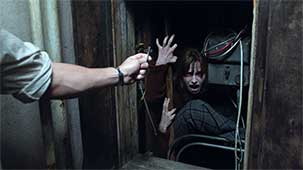It’s only fair that you know I’m a skeptic. Not to say that I don’t believe you, or that I think you’ve perpetrated some elaborate hoax. The truth is, my skepticism has less to do with spirits and possession than it does with films that proclaim that they’re “based on actual events”; they so often distort the truth to such a degree that I wonder why they bother to make any claims to veracity in the first place. Your story and the story told in the film share little resemblance; both require a willing suspension of disbelief, an ability that just doesn’t come naturally to me. Add to that my general disinterest in the horror genre itself, and, well, let’s just say The Conjuring 2 wasn’t my first choice for how to spend a pleasant Thursday evening.
So you can imagine how shocked I was to find that I kinda, sorta liked it.
Since this story is only barely recognizable to what actually (supposedly) happened to you, I’ll give you the broad strokes. It’s 1977, in Enfield, England, and a single mother and her young family (based on your family) are terrorized by the unexplained phenomena occurring in their council home. The second oldest child, Janet, seems to be the most severely affected by something that I guess can best be described as a poltergeist. In order to assess these strange occurrences, the Church sends paranormal experts – husband and wife team Ed and Lorraine Warren – to investigate. Lorraine, however, is reluctant to continue working in the field as she’s seen premonitions of Ed’s death.
In 1977, when your home started giving you trouble, public consciousness about poltergeists, demonic possession, and the occult had already been heightened by a trifecta of horror films; Rosemary’s Baby, The Omen, and, most similar to your case, The Exorcist. The Conjuring 2 director James Wan clearly understands the basics of the formula used by those films: put respected actors in lead roles, don’t rush the character’s backstories, and don’t show too much. This formula only works when you have a solid story and characters (like you) that audiences want to root for. When we care about the family, as we do here, even the slightest scares have a huge effect.
After your experiences, I’m sure you have your own reasons for not watching horror films. I didn’t see The Conjuring (though I might now), nor do I watch horror films regularly, and not because they scare me, but because (and I know I’ll probably take flack for this) I find that most of them have unlikeable characters and derivative plots that deliver only cheap visceral thrills (and I prefer to get my cheap visceral thrills elsewhere). The Conjuring 2 offers up horror movie clichés like an all-you-can-eat buffet, and the audience I screened the movie with ate them up with gusto. But the creaky floors, Dutch angles, furniture that moves, TV switching channels on its own, creepy children’s toy that comes to life, and countless other tropes don’t feel worn out in Wan’s hands. His constant camera movement, inventive blocking, and deliberate-yet-assured pacing add freshness to a film that would otherwise come across as self-indulgent nostalgia porn.
Your memories might not be so fond, but I loved the 70s. And clearly James Wan does, too. His art, hair, costume, and makeup Departments were possessed by the spirit of an editor of McCalls magazine, because the movie was not just period accurate, it was period perfect. Too often, films set in the 70s celebrate the colourful, roller-disco kitsch of the era, forgetting that most of it was swathed in dull earthtones, rococo patterns repeated into oblivion, oppressive wood furniture, bushy hairstyles, chunky knit separates, and bulky corduroy suits. When the film moves to Maggie Thatcher’s England, the tone becomes decidedly grimmer. The faux BBC TV footage of a paranormal investigation show was a particularly delightful touch.
I’m still not sure if the campiness of The Conjuring 2 is intentional, or just another 70s affectation. Vera Farmiga and Patrick Wilson, who play Lorraine and Ed Warren, seem barely able to suppress the urge to wink at the camera. Though their relationship is supposed to be the glue that holds the plot together, it’s your character, Janet, that is the real heart of the film. Played with maturity and remarkable depth by Madison Wolfe, Janet is sympathetic, yes, but we never feel that she is a victim. The hardest thing for her to endure is not demonic possession, but being separated from her family and friends. You’ll be happy to know that, despite the monumental amount of dramatic license taken by the screenwriters, Janet is not a one-dimensional horror movie child.
Near the end of the film, the scares become more obvious and the madcap pursuit of the plot’s climax, which, when it comes, has all the loose threads drawn together in a ludicrous a-ha moment, had me rolling my eyes so much I probably looked possessed. But by that point I was so invested in the outcome that, even though I couldn’t suspend my disbelief, I was able to suspend my cynicism.
As the credits roll, Wan introduces us to the real players involved in your case: you, your family, the Warrens, and other friends and professionals. I was thinking about you and your family for hours after the credits rolled, and that thrilled me more than anything I’d expected from a horror film.
Wishing you peace and quiet,
Di







